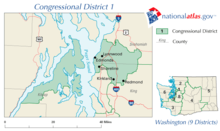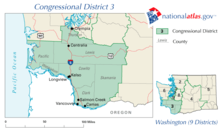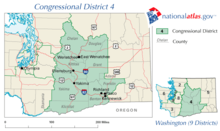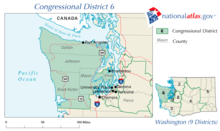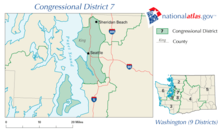- Washington's congressional districts
-
The following is a list of the nine districts in the U.S. state of Washington.
Contents
At Large
From the time that Washington Territory was formed in 1853, through statehood in 1889, Washington Territory elected an at-large non-voting Delegate to the United States House of Representatives. At different times in its history, the state of Washington has also elected one or more representatives At-large statewide.
First District
Main article: Washington's 1st congressional districtThe First Congressional District of Washington was formed in 1909 when Washington was first broken into districts. It now encompasses part of northwest Seattle and largely suburban areas north and east of Seattle including Shoreline, Edmonds, Lynnwood, Mountlake Terrace, Bothell, Kirkland and Redmond as well as Bainbridge Island and part of the Kitsap Peninsula. It is currently represented by Democrat Jay Inslee from Bainbridge Island. From 1993 to 1995, Inslee had represented Washington's Fourth District in the central part of the state.
The former House seat of powerful U.S. Senator Warren G. Magnuson, the First District was a swing district throughout much of the 1990s, changing hands and parties three times in four elections. Before the election of future U.S. Senator Maria Cantwell (D-Wash.) in 1992, the district had been in Republican hands for 40 years. Since the 1998 election when Inslee was first elected, the First District has been trending Democratic and Inslee easily won reelection in 2008.
At the presidential level, the 1st District is a relatively Democratic stronghold. Al Gore carried the district in 2000 with 53% of the vote and gave John Kerry 56% of the vote in 2004. The district swung even more Democratic in 2008, giving Barack Obama 62% of the vote and 36% to John McCain.
Second District
Main article: Washington's 2nd congressional districtWashington's Second Congressional District encompasses the northern portion of Western Washington from the vicinity of the King/Snohomish county line to the Canadian border, including the San Juan Islands. Since 2001, it has been represented by Democrat Rick Larsen.
Originally created in 1909 when Washington was broken up into districts, the Second District was represented by future U.S. Senator Henry M. "Scoop" Jackson between 1941 and 1953. It was a reliably Democratic district for most of the latter half of the 20th century until the Republican Revolution of 1994, when retiring Rep. Al Swift (D) was replaced by Jack Metcalf (R). Rick Larsen (D) has represented the district since Metcalf's retirement in 2001. In the 2008 election, Larson easily defeated Republican challenger Rick Bart.
In presidential elections, the 2nd District leans Democratic. Al Gore and John Kerry narrowly carried the district in 2000 and 2004 with 48% and 51% of the vote, respectively. In 2008, Barack Obama swept the district with 55.60% of the vote while John McCain received 42%.
Third District
Main article: Washington's 3rd congressional districtThe Third Congressional District of Washington encompasses the southernmost portion of Western Washington, from Olympia south to the Columbia River. It includes the counties of Lewis, Pacific, Wahkiakum, Cowlitz, and Clark, and the majority of Thurston and Skamania counties. The 3rd district is represented by Jaime Herrera Beutler of Camas.
Established after the 1900 census, the Third District was represented by Democrats for most of the latter half of the 20th century, until Rep. Jolene Unsoeld was defeated by maverick Republican Linda Smith as part of the Republican Revolution of 1994. Smith retired after two terms and was succeeded by Brian Baird, who himself did not run for re-election in 2010.
In presidential elections, the 3rd District is rather competitive. George W. Bush narrowly carried the district in 2000 with 48% of the vote and again in 2004 with 50%. The district swung Democratic in 2008, giving Barack Obama 52% of the vote and 46% to John McCain.
Fourth District
Main article: Washington's 4th congressional districtThe Fourth District encompasses a large area of central Washington, covering the counties of Chelan, Douglas, Kittitas, Grant, Yakima, Franklin, Benton, Klickitat, and parts of Adams and Skamania counties. Since 1995, the 4th District has been represented in the U.S. House of Representatives by Richard N. "Doc" Hastings, a Republican from Pasco.
Established after the 1910 U.S. Census, the Fourth District is predominantly rural and politically conservative and has been dominated by the Republican Party for several decades, with the exception of the 103rd Congress from 1993 to 1995, when it was represented by Democrat Jay Inslee. Hastings defeated Inslee in the 1994 election and has served in Congress ever since; Inslee later moved to Bainbridge Island and was sent back to Congress representing the First District in the central Puget Sound area. In the 2008 election, Hastings easily defeated challenger George Fearing (D-Kennewick).
In presidential elections, the 4th District is a Republican stronghold. George W. Bush carried the district in 2000 and 2004 with 62% and 63% of the vote, respectively. The 4th District also gave John McCain 58% of the vote in 2008, his strongest showing in Washington.
Fifth District
Main article: Washington's 5th congressional districtThe Fifth District encompasses the Eastern Washington counties of Okanogan, Ferry, Stevens, Pend Oreille, Lincoln, Spokane, Adams, Whitman, Walla Walla, Columbia, Garfield, and Asotin. Since 2005, the 5th District has been represented in the U.S. House of Representatives by Cathy McMorris Rodgers, a Republican. Rodgers's predecessor, George Nethercutt, somewhat famously defeated Tom Foley, the then Speaker of the House in the 1994 elections.
In presidential elections, the 5th District has generally been a safe bet for the Republicans. Although George W. Bush carried the district with 57% in 2000 and 2004, John McCain just narrowly won the district with 52% of the vote while Barack Obama received 46% in 2008.
Sixth District
Main article: Washington's 6th congressional districtThe Sixth District encompasses the Olympic Peninsula, most of the Kitsap Peninsula, and most of the city of Tacoma. Since 1977, the 6th District has been represented in the U.S. House of Representatives by Norm Dicks, a Democrat from Bremerton.
Established after the 1930 U.S. Census, the 6th District is a working class district, with many of its jobs provided by tourism and a declining timber industry on the Pacific and Juan de Fuca coasts, and by the Puget Sound Naval Shipyard in Bremerton. Dicks, who has served in the U.S. Congress for more than a decade longer than any other member of the Washington delegation, is known as a so-called "defense Democrat" who is hawkish on national defense and takes moderate positions on many issues. Dicks did not face serious opposition in the 2008 election.
Al Gore and John Kerry carried the district in 2000 and 2004 with 52% and 53% of the vote, respectively. Barack Obama swept the district in 2008 with 57% of the vote.
Seventh District
Main article: Washington's 7th congressional districtThe Seventh District encompasses most of Seattle and Vashon Island and portions of Shoreline, Lake Forest Park, Tukwila, SeaTac, and Burien. Since 1989, the 7th District has been represented in the U.S. House of Representatives by Jim McDermott, a Democrat.
A Democratic stronghold, Al Gore swept the 7th District in 2000 with 72% of the vote while John Kerry won 79% of the vote in the district in 2004. Barack Obama took in 84% of the vote in the district in 2008.
Eighth District
Main article: Washington's 8th congressional districtThe Eighth District includes most of the region known as the Eastside and the mostly rural eastern parts of King and Pierce counties. It is currently represented in the U.S. House of Representatives by Republican Dave Reichert.
Despite the Democratic voting advantage in the district, the combination of affluent suburban areas, exurban communities, and a sizable Mormon population gives this district unmistakable GOP flavor. This district could be compared to Illinois's 10th congressional district or Connecticut's 4th congressional district in terms of voting patterns.[1]
Since its creation after the 1980 U.S. Census, the 8th District has been the only Republican bastion west of the Cascade Mountains; it has never elected a Democrat to the U.S. Congress. In recent years, however, the changing demographics of the Puget Sound region have made the 8th District significantly less conservative, with voters in the district narrowly favoring Democratic presidential candidates Al Gore in 2000 and John Kerry in 2004, and favoring Democrat Barack Obama by almost 15 points over Republican John McCain in the 2008 presidential election.[2]
Ninth District
Main article: Washington's 9th congressional districtThe Ninth District encompasses a long, somewhat narrow area in western Washington that largely follows Interstate 5 through the densely-populated central Puget Sound region, from Olympia in the south to Renton in the north. Since 1997, the 9th District has been represented in the U.S. House of Representatives by Adam Smith, a Democrat from SeaTac.
Established after the 1990 U.S. Census, the 9th District is Washington's newest congressional district. It was originally drawn as a "fair fight" district. The first representative from the 9th District, Mike Kreidler (D), was defeated after one term by conservative Republican Randy Tate; Tate, in turn, was defeated after one term by Smith. Kreidler currently serves as the Washington Commissioner of Insurance, and Tate went on to succeed Ralph Reed as executive director of the Christian Coalition. Since being first elected in 1996, Smith's moderate voting record and a strong Democratic trend in the Puget Sound region have turned the formerly contentious district into a fairly safe Democratic seat. He won reelection easily in the 2008 election.
Al Gore and John Kerry each carried the 9th District with 53% in 2000 and 2004, respectively. Barack Obama won the district in 2008 with 59% of the vote.
Tenth District
Assuming there are no major successful court challenges to the 2010 U.S. Census, a Tenth District will be created during the 2011 legislative session.
References
- ^ [1]
- ^ 2008 Race Tracker. Retrieved 2009-01-06.
Washington's congressional districts All districts: Territory At-large 1 2 3 4 5 6 7 8 9 10
See also: Washington's past & present Representatives, Senators, and Delegations, 2010 elections, 2012 elections
All U.S. districts – Apportionment – Redistricting – Gerrymandering – MapsLocations in the state of Washington Communities Cities · Towns · Census-designated places (CDPs) · Undesignated communities · Unrecognized communities · Indian reservationsGeography Regions · Other places · Bodies of waterOther Categories:- Congressional districts of Washington (state)
Wikimedia Foundation. 2010.


